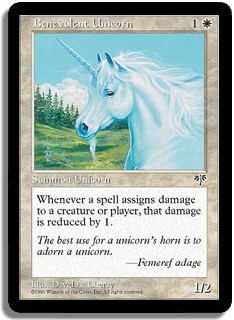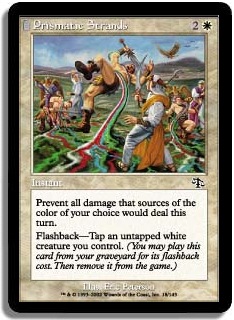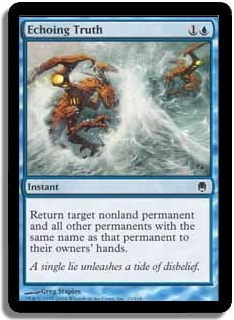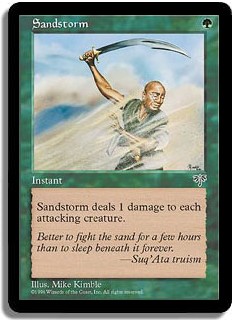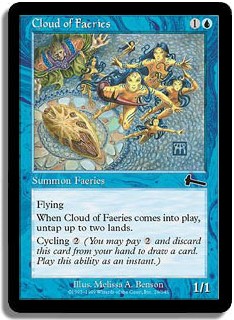If an Azorius lawmage gazed upon Pauper, they would be none too pleased. Pauper is a landscape of chaos where there is no strict order. Yes, there is a basic construct to the best (and less than best) decks, but even that hierarchy is constantly in flux. Maybe the lawmage would take some modicum of solace in knowing that one style of deck is always near the top. Of course, the good member of Azorius would investigate further, trying to discern the best way to contain the best deck and bring it in line with the edicts of the guild.
But this is no normal collection of common spells. Instead, the lawmage is confronted with ordered entropy—a perfect sequence of castings that result in a game ending. The common member of the Azorius guild has no way to stop it, even looking to other guilds. The lawmage is needled to death, assaulted by a swarm of Goblins, or is yanked from the aether.
The Azorian just encountered the big bad of Pauper—Storm—and faced the same fate as many common Magicians.
Storm is a broken mechanic—Mark Rosewater has said as much. From Scourge and Time Spiral, it allows a spell to be copied for each previous spell cast that turn. This is mitigated in part by giving these cards high mana costs, but we are competitive Magicians find ways to reduce these costs with Dark Ritual and Rite of Flame style effects.
The kill cards (Grapeshot, Empty the Warrens, and Temporal Fissure) are found via card draw and often end the game on the spot. Like other Eternal formats, the history of cheap spells makes a combo kill fairly easy to assemble, and the consistency and power of Storm decks make them attractive to those who grind Pauper for packs and wins. If a Pauper deck can’t beat Storm, it better have fantastic matchups against everything else.
So how does one beat Storm?
Storm is a problem in Pauper because it’s an uncommon threat. As I’ve written before, it’s difficult to print a common that effectively answers Storm, especially under the New World Order. There’s also no redundancy on Duress effects (Thoughtseize, Inquisition of Kozilek) or Force of Will to help keep these decks in check. Instead, Pauper decks must rely different angles of attack to take down the top dog.
Before we can attack the enemy, we must first understand what it is we are trying to defeat. Storm comes in three overarching varieties, with one hybrid deck tagging along.
Lands (12)
Spells (48)
- 4 Cabal Ritual
- 4 Dark Ritual
- 2 Chromatic Sphere
- 4 Lotus Petal
- 4 Ideas Unbound
- 2 Compulsive Research
- 2 Shred Memory
- 4 Rite of Flame
- 4 Chromatic Star
- 4 Grapeshot
- 4 Manamorphose
- 4 Sign in Blood
- 4 Gitaxian Probe
- 2 Faithless Looting
Sideboard

Spells (46)
- 3 Cabal Ritual
- 4 Dark Ritual
- 1 Seething Song
- 2 Chromatic Sphere
- 4 Lotus Petal
- 4 Ideas Unbound
- 4 Rite of Flame
- 4 Chromatic Star
- 3 Empty the Warrens
- 4 Grapeshot
- 4 Manamorphose
- 4 Sign in Blood
- 4 Gitaxian Probe
- 1 Faithless Looting
Sideboard

The Pauper Perfect Storm is easily identified by its reliance on the sacrifice lands from Invasion. While the depletion lands from Mercadian Masques make appearances, any land that provides a one shot way to produce more than one mana is going to warrant consideration. The main divergence in the above lists is one runs Empty the Warrens in the main and the other does not. In light of Electrickery, Empty the Warrens has become a far less reliable kill card. Grinder Nighthavk is the largest proponent of cutting ETW from the main and relying on a more focused Grapeshot kill, enabled in part by Shred Memory.
TPPS is a straightforward deck: you cast spells and win.Yes, there are nuances, like knowing when to play around Daze and which spells aren’t vital, but Grapeshot is a very difficult spell to stop. Prismatic Strands does the job in game 1, but Flaring Pain kills any hope of casting a Strands for value. Benevolent Unicorn does some work but is easily answered post-board. When preparing for Storm, TPPS should be at the forefront of your thought process.
Creatures (3)
Lands (15)
Spells (42)
- 4 Sleight of Hand
- 4 Desperate Ritual
- 4 Seething Song
- 4 Lotus Petal
- 4 Rite of Flame
- 4 Empty the Warrens
- 4 Ponder
- 4 Manamorphose
- 4 Preordain
- 2 Pyretic Ritual
- 4 Gitaxian Probe
Sideboard

A straight Izzet deck, Goblin Storm is slightly more explosive than TPPS, but at the same time it’s easier to stop. The motions are similar: you play cheap spells and Rituals into a kill card. Goblin Storm, as is alluded to in its name, wins with Goblins created by Empty the Warrens. As mentioned above, these tokens are fairly easy to kill with cards like Electrickery.
What’s unique about ETW is that every color has some way to answer the card (Holy Light, Echoing Truth, Echoing Decay, and Sandstorm to name a few). Goblin Storm tries to sidestep this by being faster than TPPS, often going off on turn 2 or 3. This puts incredible pressure on an opponent, forcing them to hold back threats in favor of attempting to cast an answer.
Creatures (19)
- 4 Cloud of Faeries
- 4 Sunscape Familiar
- 4 Nightscape Familiar
- 3 Mulldrifter
- 1 Mnemonic Wall
- 3 Sea Gate Oracle
Lands (22)
Spells (19)

The deck that got Frantic Search banned operates along a slightly different path than its Storm brethren. Instead of using Ritual effects to generate mana, it instead combines Cloud of Faeries and Snap with Ravnica Block bouncelands and Nightscape Familiar and Sunscape Familiar from Planeshift to generate oodles of mana. Then the deck uses Mnemonic Wall, Ghostly Flicker, and Toils of Night and Day to generate more mana and rebuy Snap (with Wall) to continue bouncing Cloud to generate a high enough storm count to use Temporal Fissure to remove all opposing permanents from the board and win with attacking Mulldrifters and the like. Even if the enemy rebuilds, Temporal Storm can just loop the cycle again the next turn thanks to bounce and Mnemonic Wall.
This is the most resilient of the Storm decks, but it also takes the longest to set up victory.
Spells (36)
- 1 Fireblast
- 4 Desperate Ritual
- 4 Spark Spray
- 4 Lava Dart
- 4 Lotus Petal
- 4 Rite of Flame
- 4 Empty the Warrens
- 3 Crimson Wisps
- 4 Manamorphose
- 4 Gitaxian Probe
Sideboard

The final deck is a hybrid of Burn and Storm. Eschewing a second color entirely, this deck is all Rituals and cantrips, simultaneously trying to create a large Kiln Fiend while whittling away a life total while also generating a large enough storm count to win with Empty the Warrens. The deck is extremely explosive, but it can also be fragile. It lacks the card draw and filter of the other Storm decks and is even more reliant on the opening hand than Goblin Storm.
All Storm decks operate along a similar starting axis: playing multiple spells. In order to do this, they all require mana and time. Regardless of the variance of time (from two to five turns), all Storm decks need these ingredients to prepare their game-ending meal.
It makes sense then to attack Storm along these very metrics—denying them time and/or mana is part of a path to victory. This isn’t a panacea, as one doesn’t exist at common. Rather, understanding this piece of information gives us insight into how to begin to fight Storm.
Before delving into this, however, it would benefit everyone to look at the existing “answers” to specific cards in Storm.
Grapeshot
The best “answer” to the needle of death is Benevolent Unicorn. This Mirage common reduces the amount of damage dealt by each copy of Grapeshot to exactly zero. Flaring Pain doesn’t stop this because it is damage reduction, not prevention. Protecting Benevolent Unicorn is important, and tag-teaming with Benevolent Bodyguard can help to keep the horse on the table. That being said, many Grapeshot decks come prepared with removal in the sideboard to help remove the offending creatures.
The other big “answer” to Grapeshot is Prismatic Strands. Strands shuts down all damage and can do so from the graveyard as well (making it a better option than Safe Passage). However, a Flaring Pain at any moment can stop Strands from working.
A quick note: Standard Bearer and Coalition Honor Guard do nothing against Grapeshot (and Temporal Fissure for that matter). The wording on these cards is that only the casting of the spell must target them. Storm places copies on the stack, and these copies are not cast. Don’t get caught thinking that this works.
Temporal Fissure
Aside from creatures like Silhana Ledgewalker, Guardian of the Guildpact, Yavimaya Barbarians, and their ilk, there’s one spell from Return to Ravnica that helps to shut down the effectiveness of Fissure: Mizzium Skin. Casting this can stave off the Cyclonic Rift for a turn, which might just be enough time to win. Many Temporal decks run countermagic and Dispel, however, so this isn’t always an airtight plan.
Empty the Warrens
The kill card with the most available answers. Even before Return to Ravnica, there was an abundance of answers to Goblin tokens. In addition to Prismatic Strands, Fog and Moment’s Peace help to buy a turn. In the “actually kill the tokens” department, the following cards have been run to great effect: Holy Light, Echoing Truth, Fade Away, Crypt Rats, Echoing Decay, Festercreep, Nausea, Shrivel, Wail of the Nim, Bloodfire Dwarf, Krark-Clan Shaman, Martyr of Ashes, Seismic Shudder, and Sandstorm. That is the largest list of answers to any Storm card in Pauper. Of course, now Electrickery is a thing and changes the landscape entirely.
Aside from Echoing Decay, Echoing Truth, and Crypt Rats, the cards listed above have very little utility against the field. Electrickery is better than all of these since it can take out multiple important creatures in Pauper (Delver of Secrets, Spellstutter Sprite, and Glistener Elf to name a few) while also acting as a sweeper in certain matchups. With more of these spells being maindeck material, the splash damage to Empty the Warrens increases, which makes the prospect of winning with Goblin tokens less likely (although some people will go deep with Goblin Caves, for example).
These are the cards that help the fight, but they mostly buy time. Even timed perfectly, Storm can still recover. Combining these cards with the strategies that follow can do wonders to help improve your Storm matchup.
The first prong of attack is limiting Storm’s mana. The most obvious way to do this is to blow up their lands. Both TPPS and Temporal Storm rely on lands that enter the battlefield tapped, meaning that Stone Rain and the like can set these decks back two turns (or more in the case of bouncelands). This seems like a great reason to run land destruction, right?
Not exactly. One Stone Rain might set back Temporal Storm for two turns, but the deck is excellent at blocking and recovering from hate. So while you spend a turn destroying a land, unless you can follow it up with more land kill effects AND effective threats, Temporal Storm will eventually come back. Similarly, TPPS can operate off of one land (or none with enough Lotus Petal), so taking one away on turn 3 is a risk.
Raze is an option, especially after playing a threat on turn 1. Following up Raze with more pressure can severely impact the mana of Storm and compress the time they have to go off. Raze itself, however, requires a very specific deck and isn’t currently viable given the abundance of Spellstutter Sprites currently being played. However, that very answer helps to inform the other aspect of limiting Storm’s mana: choke points.
The goal is to find the choke points in mana for Storm decks. This can be as simple as countering their first Ritual or as complex as knowing exactly when they’re digging for an answer. The best way to stop this is through counterspells, which limits the strategy to blue, white (if only temporarily), and red (for card drawing).
Black can attempt to create a choke point as well via discard. Knowing what to take with Duress or Distress can help to create a choke point if nabbing a key ritual effect. This is in part why black Rats decks are successful—they can take a key card by choice and force the others to be discarded, severely limiting the ability of Storm to generate mana.
All of these are designed to do the same thing: prolong the amount of time the non-Storm deck has to win the game. There’s also another strategy available: compressing the amount of time Storm has to go off (otherwise known as racing).
Racing is usually done in conjunction with constricting mana, but not always. A deck like Infect, for example, is designed to win before Storm can (and is one of the reasons why the deck is successful). Decks that win through attacking must quickly apply pressure. Take, for example, a non-Infect Stompy list. By playing creatures and pump spells, Stompy can threaten lethal as early as turn 3 (although turn 4 is more likely). This puts Storm under a tight clock. While TPPS and Goblin Storm both can win by turn 3, they don’t always have the pieces to do it. If they’re facing down a lethal attack, Storm might attempt to go off prematurely and be unable to craft a win.
These two methods can be imagined on a temporal continuum. At the start of any game, the scale is heavily weighted towards Storm, but acting in a way that can limit Storm’s mana and increases your own tempo helps to shift the “weight” towards the non-Storm deck. Infect, for example, can shift the matchup by playing a turn 1 Glistener Elf, which immeidately becomes a threat to win the game on turn 2. However, all this work can be undone by Storm drawing the right piece to undo the shift, so it’s best to attack Storm from multiple angles. The best examples of this are Delver Blue and Rats.
Delver Blue can establish a threat early and then use its spells to keep Storm in a bottleneck. This is doubly effective since Cloud of Faeries is effectively free and Spellstutter Sprite doubles as disruption and a body. Add Counterspell and Spire Golem for the later game and Delver can finish off Storm before it gets all its ducks in a row. Storm can offset this strategy by playing a patient game and loading up on pieces so the counters don’t matter, but that just gives Delver more time to win.
Rats doesn’t have the same stopping power of Counterspell. Instead, it can set up a sequence with Duress followed up by Ravenous Rats, Chittering Rats,and Liliana’s Specter. These can overload Storm’s hand and force it to go off early. Following any of these up with a surprise Okiba-Gang Shinobi can spell the end of the game for Storm. When given the choice of discard with Duress, take a look at their hand—oftentimes it’s the wrong play to take their kill card. Removing a Ritual or draw spell can often buy you more time. The exception is, of course, if it’s their last kill card. Post-board, Storm decks might side in Deep Analysis as protection against discard. And sometimes all the discard just doesn’t matter, as Storm just powers through anyway.
Storm is a limiting factor of the Pauper format. It helps to give the format structure, but at the same time it breeds chaos. By presenting a true clock, all decks must be designed with Storm in mind. Remember the temporal axis, and take steps to steal time for your brews. If you want to race, that’s fine, just remember to disrupt. Control your game? Better find a way to stop Storm until you can take over the match. There are rules to any format, and Storm helps create them for Pauper. All is not lost, as any set of laws has loopholes.
Keep slingin’ commons-
-Alex
SpikeBoyM on Magic Online
@nerdtothecore
The Colors of Pauper:

